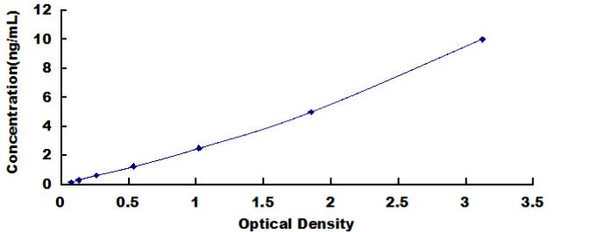Enzymes Recombinant Proteins
Human PKAkt1/PKBa Recombinant Protein (RPPB2615)
- SKU:
- RPPB2615
- Product Type:
- Recombinant Protein
- Species:
- Human
- Uniprot:
- P31749
- Research Area:
- Enzymes
Description
| Product Name: | Human PKAkt1/PKBa Recombinant Protein |
| Product Code: | RPPB2615 |
| Size: | 20µg |
| Species: | Human |
| Target: | PKAkt1/PKBa |
| Synonyms: | RAC-alpha serine/threonine-protein kinase, EC 2.7.11.1, RAC-PK-alpha, Protein kinase B, PKB, C-AKT, AKT1, AKT, RAC, PRKBA, MGC99656, RAC-ALPHA. |
| Source: | Sf9 Insect cells |
| Physical Appearance: | Sterile Filtered clear solution. |
| Formulation: | PKAkt1 in 50mM Tris-HCl, 100mM NaCl, 1mM DTT, 25mM beta glycerophosphate, 50% glycerol, pH 8.5. |
| Stability: | Store at 4°C if entire vial will be used within 2-4 weeks.�Store, frozen at -20°C for longer periods of time.�Avoid multiple freeze-thaw cycles. |
| Purity: | Greater than 90% as determined by SDS-PAGE. |
| Biological Activity: | No protease activity (Twinning test).�The Specific activity is 235 U/mg. |
Akt1, also known as "Akt" or protein kinaseB (PKB) is an important molecule in mammaliancellular signaling.In humans, there are three genes in the "Akt family": Akt1, Akt2, and Akt3. These enzymesare members of the serine/threonine-specific protein kinasefamily (EC2.7.11.1).Akt1 is involved in cellular survival pathways, by inhibiting apoptoticprocesses. Akt1 is also able to induce protein synthesispathways, and is therefore a key signaling protein in the cellular pathways that lead to skeletal muscle hypertrophy, and general tissue growth. Since it can block apoptosis, and thereby promote cell survival, Akt1 has been implicated as a major factor in many types of cancer. Akt (now also called Akt1) was originally identified as the oncogenein the transforming retrovirus, AKT8.
PKAkt1 is a glycosilated polypeptide having a molecular mass of 59.1 kDa, fused with a polyhistidine tag at N-terminus (to facilitate removal of Akt1 kinase from the reaction mixture).Inactive enzyme, suitable for negative control experiments or for phosphorylation as a substrate.Recombinant Protein Kinase B is purified by proprietary chromatographic techniques.
| UniProt Protein Function: | Akt1: an oncogenic AGC kinase that plays a critical role in regulating cell survival and metabolism in many different signaling pathways. Dual phosphorylation is required for its activation. T308 is phosphorylated by PDK1 in the PI3 kinase pathway, and S473 is phosphorylated by mTOR in the mTORC2 pathway. The 'Lys-63'-linked ubiquitination of AKT1 by TRAF6 is important for its translocation to the plasma membrane, phosphorylation, and activation. When Akt is fully phosphorylated it translocates into the nucleus, undergoes 'Lys-48'-polyubiquitination catalyzed by TTC3, leading to its proteosomal degradation. Hyperactive or overexpressed in a number of cancers including breast, prostate, lung, pancreatic, liver, ovarian and colorectal. Over 160 protein substrates are known including many that regulate transcription, metabolism, apoptosis, cell cycle, and growth. |
| UniProt Protein Details: | Protein type:AGC group; AKT family; EC 2.7.11.1; Kinase, protein; Oncoprotein; Protein kinase, AGC; Protein kinase, Ser/Thr (non-receptor) Chromosomal Location of Human Ortholog: 14q32.33 Cellular Component: cytoplasm; cytosol; microtubule cytoskeleton; nucleoplasm; nucleus; plasma membrane; vesicle Molecular Function:ATP binding; enzyme binding; identical protein binding; kinase activity; nitric-oxide synthase regulator activity; phosphatidylinositol-3,4,5-triphosphate binding; phosphatidylinositol-3,4-bisphosphate binding; protein binding; protein kinase activity; protein serine/threonine kinase activity; protein serine/threonine/tyrosine kinase activity Biological Process: activated T cell apoptosis; cell differentiation; cell proliferation; cellular response to insulin stimulus; endocrine pancreas development; G-protein coupled receptor protein signaling pathway; G1/S-specific positive regulation of cyclin-dependent protein kinase activity; insulin receptor signaling pathway; insulin-like growth factor receptor signaling pathway; negative regulation of apoptosis; negative regulation of autophagy; negative regulation of caspase activity; negative regulation of fatty acid beta-oxidation; negative regulation of protein kinase activity; negative regulation of proteolysis; nitric oxide biosynthetic process; peptidyl-serine phosphorylation; peptidyl-threonine phosphorylation; phosphoinositide-mediated signaling; phosphorylation; platelet activation; positive regulation of blood vessel endothelial cell migration; positive regulation of cell growth; positive regulation of cellular protein metabolic process; positive regulation of endodeoxyribonuclease activity; positive regulation of endothelial cell proliferation; positive regulation of epidermal growth factor receptor signaling pathway; positive regulation of fat cell differentiation; positive regulation of glucose import; positive regulation of glycogen biosynthetic process; positive regulation of lipid biosynthetic process; positive regulation of nitric oxide biosynthetic process; positive regulation of nitric-oxide synthase activity; positive regulation of peptidyl-serine phosphorylation; positive regulation of protein amino acid phosphorylation; positive regulation of smooth muscle cell proliferation; positive regulation of transcription factor activity; protein amino acid autophosphorylation; protein amino acid phosphorylation; protein import into nucleus, translocation; protein modification process; regulation of cell migration; regulation of glycogen biosynthetic process; regulation of mRNA stability; regulation of nitric-oxide synthase activity; regulation of phosphoinositide 3-kinase cascade; response to heat; response to oxidative stress; signal transduction; T cell costimulation Disease: Breast Cancer; Colorectal Cancer; Cowden Syndrome 6; Ovarian Cancer; Proteus Syndrome; Schizophrenia |
| NCBI Summary: | The serine-threonine protein kinase encoded by the AKT1 gene is catalytically inactive in serum-starved primary and immortalized fibroblasts. AKT1 and the related AKT2 are activated by platelet-derived growth factor. The activation is rapid and specific, and it is abrogated by mutations in the pleckstrin homology domain of AKT1. It was shown that the activation occurs through phosphatidylinositol 3-kinase. In the developing nervous system AKT is a critical mediator of growth factor-induced neuronal survival. Survival factors can suppress apoptosis in a transcription-independent manner by activating the serine/threonine kinase AKT1, which then phosphorylates and inactivates components of the apoptotic machinery. Mutations in this gene have been associated with the Proteus syndrome. Multiple alternatively spliced transcript variants have been found for this gene. [provided by RefSeq, Jul 2011] |
| UniProt Code: | P31749 |
| NCBI GenInfo Identifier: | 60391226 |
| NCBI Gene ID: | 207 |
| NCBI Accession: | P31749.2 |
| UniProt Secondary Accession: | P31749,Q9BWB6, B2RAM5, B7Z5R1, |
| UniProt Related Accession: | P31749 |
| Molecular Weight: | 48,347 Da |
| NCBI Full Name: | RAC-alpha serine/threonine-protein kinase |
| NCBI Synonym Full Names: | AKT serine/threonine kinase 1 |
| NCBI Official Symbol: | AKT1�� |
| NCBI Official Synonym Symbols: | AKT; PKB; RAC; CWS6; PRKBA; PKB-ALPHA; RAC-ALPHA�� |
| NCBI Protein Information: | RAC-alpha serine/threonine-protein kinase |
| UniProt Protein Name: | RAC-alpha serine/threonine-protein kinase |
| UniProt Synonym Protein Names: | Protein kinase B; PKB; Protein kinase B alpha; PKB alpha; Proto-oncogene c-Akt; RAC-PK-alpha |
| Protein Family: | AKT-interacting protein |
| UniProt Gene Name: | AKT1�� |






